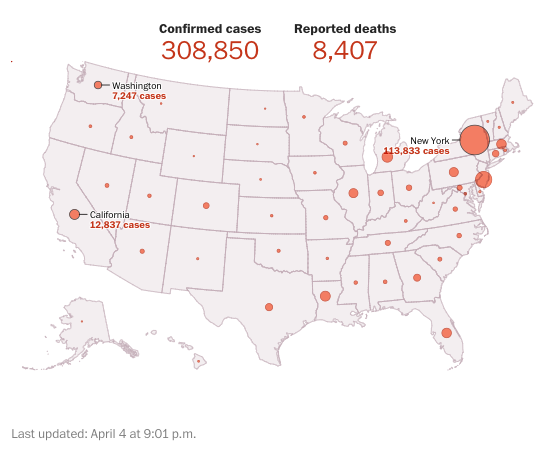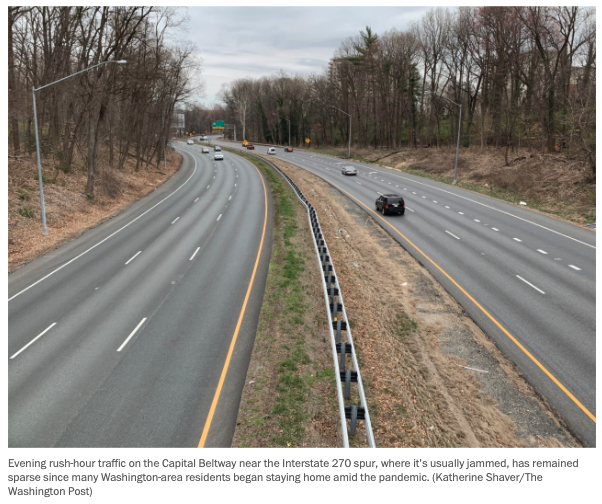President Trump reiterated warnings from the last several press briefings on Saturday, indicating that the country should brace for the “toughest week” yet, as confirmed cases and deaths continue to rise on an exponential curve.
And despite the more than 308,000 cases and 8,407 deaths, Americans continue to defy the stay-at-home government enforced orders that cover 90% of the country.
Traffic analytics firm INRIX transportation told The Washington Post that daily traffic nationwide remains around 60% of normal levels. The highways are still filled with vehicles as many resist public health lockdown orders:
“In California, where a stay-at-home order took effect March 19, daily trips statewide remain at 58% of normal levels, according to Wejo, a British company that collects data from sensors in some passenger vehicles.
On Wednesday – two days after the District of Columbia, Virginia and Maryland enacted stay-at-home orders – daily car trips in the region remained at 51% of normal in D.C., 53% in Maryland and 59% in Virginia, according to Wejo, which does not include trucks or other commercial vehicles.
Washington state officials announced a stay-at-home order March 23. More than a week later, distances traveled on Seattle roads remained at about 55% of normal, according to INRIX, a Kirkland, Washington-based traffic analytics firm that crunches data from vehicle navigation systems, cellphones and other devices,” reported The Post.
With traffic halved across major metros and along many highways is unprecedented – it’s becoming evident that plenty of Americans are still on the roads despite strict stay-at-home public health orders across the country.
“Some of the remaining traffic, experts say, stems from motorists heading to and from the many worksites that have been deemed “essential”: health-care facilities, supermarkets and liquor stores, construction sites, banks, dry cleaners, hardware stores, pet stores, government facilities, and auto and bicycle repair shops, among others. The Washington region’s orders also exempt plumbers, electricians and others needed for home repairs,” said The Post.
The resistance to shutdown states and or even certain geographical regions has been evident by lawmakers in the Southern US and Rust Belt.
Kay Ivey, the Republican Gov. of Alabama, said now is “not the time to order people to shelter in place.”
“Y’all, we are not Louisiana, we are not New York state, we are not California,” Ivey said, suggesting that Alabama would not be a hard-hit area of the country.
In Missouri, Republican Gov. Mike Parson has been late to the game in issuing a stay-at-home order, that will go into effect on Monday. Parson was recently heard stating that he will not “make a blanket policy,” adding, “It’s going to come down to individual responsibilities.”
Florida Republican Gov. Ron DeSantis has also been late in issuing a stay-at-home order, which was finally put forth last week amid rising deaths and cases across the state.
Tampa-area megachurch Pastor Rodney Howard-Browne defied a local order on banning of mass gatherings last weekend by holding a church service – was arrested by authorities on Monday.
Over the last month, President Trump has shifted his rhetoric on the virus from calling it “hysteria” and a Democratic hoax, to now announcing the outbreak as a national emergency and urging all Americans to work from home and avoid public spaces. However, a large swath of Americans still believes the virus is “fake news,” and are not letting the virus affect their daily lives, which suggests containing the virus might be even more difficult than expected for government agencies, and why stricter lockdowns could be next.
As for more stringent lockdowns that could be ahead, take note of what happened in Panama last week, as the government issued a gender-based lockdown limiting male and female from traveling to the supermarket on certain days. There’s even rumor in Mid-Atlantic/ Northeast states, that tighter lockdowns could be ahead as National Guard troops position around major metros.
And with many Americans resisting lockdowns, we noted last week that “intermittent” lockdowns and “widespread surveillance” to mitigate the virus spread could be the norm through 2022.

